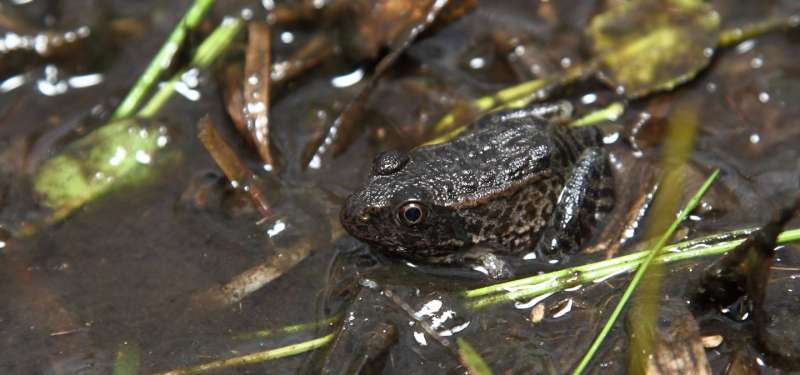
Sunny Weekend Alert
The Zoo anticipates high attendance on sunny weekends. Parking is limited, so arrive early, carpool, and check our site / social pages often for more updates!
The Zoo anticipates high attendance on sunny weekends. Parking is limited, so arrive early, carpool, and check our site / social pages often for more updates!

Written by Chris Shupp, Zookeeper Supervisor (Cypress Swamp/Desert), North Carolina Zoo
It’s a muggy June evening in the Sandhills of North Carolina. The Zoo's team has just released another batch of newly metamorphosed Carolina gopher frogs (Rana capito) back to the pond where they were collected as eggs just a few short months ago. These frogs are about to run a gauntlet of snakes, turtles, birds and red imported fire ants (among other things) that all young frogs experience as they transition from egg to tadpole and finally to frog. Their survival is determined by whether they can navigate from the ponds to the upland …and the security of a stump hole. With any luck, maybe a few will live long enough to reach maturity, make it back to the pond to reproduce and complete the cycle.
The North Carolina Sandhills are characterized by rolling hills, rich diversity, and many rare, threatened, or endangered plants and animals. Due in large part to habitat loss and fire suppression, much of the original longleaf pine ecosystem has been lost. However, due to significant restoration efforts, the sandhills game lands represent some of the largest and most intact remnants of the longleaf pine ecosystem in North Carolina. Longleaf pine ecosystems once stretched across the South (nearly unbroken) from Virginia to Florida to Texas. Today, sadly, less than five percent of the original 90-million acres remain. That’s like going from an area roughly three times the size of North Carolina …down to an area the size of Delaware!

Chris Shupp collecting gopher frog eggs
In North Carolina, gopher frogs are an endangered species found only in high-quality longleaf pine ecosystems with healthy ephemeral ponds (ponds that completely dry from time to time and lack fish). The frogs live primarily in upland stump hole cavities and breed in the nearby ponds, generally during late winter to early spring. Sometimes these winter breeding pond migrations can cover more than two miles! This demonstrates just how much space these frogs really need. Historically, their range in North Carolina extended from the Sandhills to the coastal plain and was represented by approximately 50 ponds and 30 populations …currently, only seven populations remain active, none of which are currently in a healthy and fully sustainable state.
In 2014, the North Carolina Zoo began a partnership with the North Carolina Wildlife Resources Commission (NCWRC) in the sandhills game lands. In 2016, this partnership transitioned to the headstarting program with gopher frogs that is ongoing at the North Carolina Zoo.
To date, we have collected eggs from 110 egg masses spanning five years and six seasons. There was even a breeding event during Hurricane Florence in September of 2018 that allowed us to try the headstarting process through the winter.
The general process of “headstarting” involves collecting eggs from the pond within a few days of being deposited. The softball-sized egg masses can contain 500 or more eggs, and we try only to remove less than t five percent of the eggs for headstarting. These eggs are then carefully transported to the Zoo. Once there, the eggs are moved to a small hatching container, and we attempt to count the eggs, which is not an easy task! The eggs are maintained in their hatching container until they hatch and are ready for their next move …to the large outdoor mesocosms. In this case, a mesocosm is a 300-gallon stock tank that contains water and plant matter (called maidencane) that provides cover for the tadpoles and surface area for algal growth, …which is what the tadpoles eat. Usually, the tadpoles spend about three months developing in these mesocosms, before completing their metamorphosis and being released back to the pond they were collected.

Outdoor mesocosm full of gopher frog eggs
To date, we have released approximately 800 metamorphosed gopher frogs back to the North Carolina longleaf ecosystem. With each successive year, the partnership that we have developed with the dedicated herpetologists of the NCWRC continues to motivate us toward our ultimate goal of reversing the trends of amphibian declines …especially in our backyard.

Gopher frog metamorph
Future goals include continuing to headstart gopher frogs and expanding our commitment to headstarting other state or federally listed threatened or endangered amphibians, such as the ornate chorus frogs (Pseudacris ornata).
For a more comprehensive description of the process, check out this video by WUNC-TV: